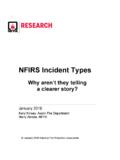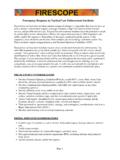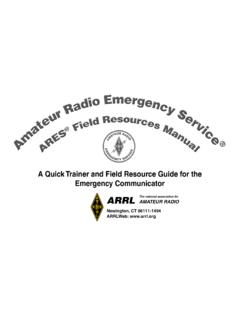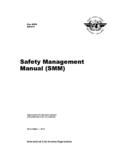Transcription of Case Study Proposal - UniTelME
1 The Fires that created an incident management System Dale D. Rowley Abstract From September 22 to October 4, 1970, 773 wildfires in Southern California, burned 576,508. acres, destroyed 722 homes and killed 16 people. From these 13 days of death and destruction by out-of-control wildfires in the Urban-Wildland Interface, a Federally-funded project was created in California called the FIrefighting REsources of Southern California Organized for Potential Emergencies or otherwise known as FIRESCOPE. Out of the FIRESCOPE research project came two new concepts, the incident Command System (ICS) and the Multi-Agency Coordination System (MACS). Introduction For many years, local fire departments, police departments, EMS units and emergency managers operated within local incident management systems (IMS) that varied according to local historical and political experiences. Changes in these systems followed major emergency and disaster incidents.
2 Two separate incidents occurred in the nation that led to revolutionary changes in the process of managing incidents. The first incident involved a series of wildfires which led to a statewide system that slowly evolved into a functional IMS used by the wildland fire service and by a federal maritime agency. The second incident involved the largest international terrorist attack in the nation's history. This second incident took the basics of the state incident management system and built a National incident management System or what is now referred to as NIMS. As with the state system, total acceptance, incorporation and competency will most likely take a generation. 1. Before incident Command All fifty state legislatures have enacted state laws relating to disasters and major emergencies. Typically, the laws define terms, establish organizations, assign responsibilities and authorities and describe financial requirements.
3 In California, the state legislature enacted an Emergency Services Act that provides direction for the state during emergencies. This Act also called for all emergency response agencies in the State of California to operate under a State Fire Disaster Plan which is coordinated by the Fire and Rescue Division of the Office of Emergency Services during a major wildland fire. Depending on the nature and extent of a fire disaster, there is therefore a planned build-up of fire control assistance from the local, to the state, to the federal level. (California Aflame p. 31) This was the process that was in place in 1970. In the fall of 1970, the conditions for a major wildland disaster were present in California and the State's local, state and federal firefighters waited for the shoe to drop. Southern California had experienced little or no rain in six months. In mid-September the humidity dropped to ten percents and at various times the humidity dropped to around one to two percent.
4 Temperatures were averaging over 100 degrees Fahrenheit day after day. Winds were gusting; at times the wind velocities were hurricane strength. (California Aflame p. 3). Then it began. It all started when a man set his match intentionally to tinder-dry grass along the Fish Ranch Road in the hills behind Oakland. Within minutes flames, feeding on dry coyote brush and pine trees and whipped by a strong northeast wind, swept to the ridge top and leaped into homes perched on the steep hillside above San Francisco Bay. In less than two hours fire completely destroyed 36 homes, badly damaged 37 others, and desolated 230 acres of valuable watershed. (California Aflame ) However, no one expected that this fire would grow to the size it did and have the impact that it did on California firefighting. 2. The 1970 fire disaster was unique in modern times, primarily in terms of geographical area involved, total acreage burned, the wildland-urban nature of the fires, and the large number of agencies, people, and equipment involved.
5 Not since the Bar Harbor Fires in Maine in 1947, perhaps, has such a widespread disaster of similar nature occurred. Control of California's 1970. catastrophe depended upon the nationwide depth of the United States Forest Service, the statewide depth of the California Division of Forestry, and execution of the State Fire Disaster Plan under which men and equipment from many communities converged upon the various fires, providing assistance to local firefighting forces. (California Aflame, p. 1). After thirteen days of fire, the California firefighters managed to stabilize the disaster. The statewide disaster ended--slowly, stubbornly--when the Fire Boss of the 34,000 acre Meyers Fire in southern California determined his fire had been wholly surrounded by a line cleared of flammable fuel. (California Aflame, p. 1) During those thirteen days, 773 individual wildfires swept across Southern California and burned almost 580,000 acres.
6 The fires completely destroyed 722 homes when they burned isolated residences or spread from the hills into urban communities. Sixteen lives were lost, attributed directly to the fire activity. Suppression costs and damages together were estimated at 233 million dollars. (California Aflame ). This damage would equate to $ billion in 2006. Thirty-two of the 773 wildfires became large fires or 300 acres or larger and accounted for 93 percent of the total acreage burned and 89 percent of the homes that were completely destroyed. (California Aflame p. 4). Early fire suppression efforts were able to control the other 741 small fires. A remarkable job had been accomplished by the California firefighters, considering the conditions that existed. However, despite the Herculean efforts, many things went wrong that allowed the disaster to grow to the size that it did. (California Aflame p. 4). 3.
7 One of the difficulties that came to light was the ability to control and coordinate the vast numbers of firefighters and other emergency responders. Because the fire disaster was reaching such widespread proportions and involved the firefighting apparatus of so many separate fire departments, there was need for a coordinating body. Therefore, in accordance with the State Fire Disaster Plan, Region 1 GHQ [General Headquarter] was established at Los Angeles County Fire Department Headquarters. (California Aflame p. 19). Early in the fire disaster, the State of California found that the numbers of firefighting resources in the State were insufficient to stabilize the emergency. In the wake of the fire disaster and total commitment of state forces, Governor Reagan applied for federal assistance from the Office of Emergency Preparedness. As a result of this application, the state received considerable help, especially from military forces and from highly trained and experienced Indian crews flown in from several western states.
8 (California Aflame p. 19) With the Federal government's response came new capabilities that would become standard in future responses. Satellite photographs were provided by the ESSA 8 satellite circling overhead, demonstrating its potential for providing fire intelligence in future years. (California Aflame p. 21) Because firefighters were spread so thin, there was no one on the ground or in the air to report on several of the wildfires in remote locations. Only the use of the Forest Service's infrared scanner, flown to California from the Boise, Idaho, Interagency Fire Center, permitted firefighters to maintain continuous vigil of the [Buckeye Fire] fire's location and progress.. (California Aflame p. 23) However, with the vast numbers of local, state and Federal resources that became involved in the 1970 California wildfires, some resources were not effectively utilized, while other resources were used to the point of exhaustion.
9 Existing methods of managing the incident soon proved to be insufficient. 4. On September 28th, midway through the nearly two week incident , the number of firefighters and equipment peaked with probably some 19,500 professional firemen from about 500. separate departments and agencies were involved with wildland fires in California on that day, through mutual aid agreements, the State Fire Disaster Plan, and inter-state and intra-state movement of forces. Thousands of other people were also involved in the suppression effort or in support roles. (California Aflame p. 24) Never before had California, nor anywhere in the United States, experienced a disaster that involved such large numbers of responders. California's State Fire Disaster Plan , as organized by the Division of Fire and Rescue of the State Office of Emergency Services (OES), was specifically developed to coordinate resources with local communities and to mobilize and deploy these resources statewide.
10 The Plan established procedures for managing statewide voluntary mutual aid programs, integrated state-owned fire response equipment into the mutual aid program and converted the voluntary program into a mandatory program when the Governor proclaimed a State of Emergency . (California Aflame p. 37). The Statewide Dispatching Center in Sacramento immediately went into an expanded 24- hour a day manning pattern to coordinate the statewide movement of men and equipment.. (California Aflame p. 35) Informal information connections existed with the ad hoc General Headquarters (GHQ) in Los Angeles, the Sacramento Headquarters of the Division of Forestry, Ranger Unit and District Headquarters Offices. (California Aflame p 35) Difficulties came with these separate control centers all having a segment of the firefighting response. Various agencies had sent top level representatives to form the Board of Strategy of Region I GHQ.





